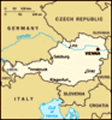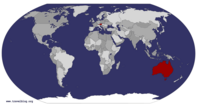Advertisement
Published: July 18th 2006
Sweat poured off my head and the bottle of water I brought with me provided little relief. Still, the wet sauna at the Amalienbad pool and bath wasn’t unbearable, and it proved to be very clarifying after three days of walking, pedaling and riding the tram around Vienna.
I was soon joined by a middle-aged Austrian man, who upon sitting next to me, opened up with what sounded like a question in German. Now, it had been more than a decade since I had bluffed and stuttered my way through high school German, which I only took because I needed two years of a foreign language to get into a Washington State university, and the little German I remembered was limited to part of U.S. Pledge of Allegiance that we had to say in “Deutsche” at the start of every class.
I shrugged my shoulders and said, “I’m sorry, I only speak English.”
Without missing a beat, Sauna Man nodded, pointed to my nearly knee-length swim trunks, and told me, in English, that I wasn’t supposed to be wearing anything, save for a towel to wipe off the sweat. I apologized and told him that in America we usually
wear something when we go to the sauna.
He leaned his head back and cracked out a quick laugh. “Ah, you Americans are very coy!”
We talked and sweated a bit more before I took my leave. I had to agree with him about the “coy” remark, especially coming from a resident of Vienna, a city that I learned has never been coy about how it has presented itself on the world stage.
Up until the early 20th century, the great empires of Europe were known for building monuments to themselves that were so grand, and at times so gaudy that they would probably make even Donald Trump blush with self-embarrassment. World War I put an end to the invincibility of the old empires, and the Austrian Empire (and later, Austro-Hungarian Empire), run by the Hapsburg family for more than 600 years. was no exception. Karl I, the last Hapsburg ruler abdicated in 1918, but not before the family dynasty had turned Vienna into its own private architectural playground with a building binge that would put to shame any American real estate developer’s idea of what a “planned community” should look like.
Vienna can thank Franz Josef,
the Hapsburg Emperor from 1848 until his death in 1916, for much of the city’s downtown…well…imperial look and feel. Beginning in 1857 Franz Josef set upon a massive campaign that tore down Vienna’s old walls, rebuilt the city, and created a downtown area called the Ringstrasse, popularly known as The Ring. The story is that Franz Josef wanted to outdo Napoleon’s renovating of Paris; whether he succeeded might be a matter of debate, but even a cursory look around Vienna leaves no doubt about the Emperor’s ambitions.
Majestic only begins to describe the fruits of Franz Josef’s architectural whirlwind. Much of the architecture is in the High Renaissance style, and columns and pilasters are part of almost every building. Many of Vienna’s most-famous works of architecture are within the Ring, including St. Stephen’s Cathedral with its tiled roof of chevrons, the Votive Church and its twin Gothic towers and the Austrian Parliament building.
But it’s Vienna’s museums that truly stand out within the Ring, and two of the best, and nearly completely opposite in terms of style and collections, are the Museum of Art History and the Secession Museum.
In some ways, the Hapsburgs were like any
other family in that they liked to exhibit mementos of their travels and pictures of people and places that held special meanings to them. The only differences are instead of the average family’s snow globe from Disneyland, the Hapsburgs had Canova’s Theseus & the Minotaur sculpture, and instead of a photo of Aunt Millie at the Golden Gate Bridge, the Hapsburgs adorned their walls with self-portraits of Rembrandt and Rubens.
The Museum of Art History is simply massive, both in its physical size and the scope of its collections. Completed in 1891, the museum reflects the Hapsburgs addiction to artwork and showing off the vastness of their empire. It’s not hyperbolic to say that everything is here: Egyptian collections, Greek and Roman antiquities and works by the Flemish, Dutch and Italian masters only begin to hint at the amount of artwork with the museum’s walls. The museum can be seen in a day, but it’s exhausting, and your feet will thank you for spending a second day to take in the whole place.
While the Museum of Art History might be an example of art, and architecture taken to the extreme, the Secession Museum is its philosophical opposite.
Secessionism was born in Vienna in 1897, when a group of 19 progressive artists broke away from the conservative art schools of that day in order to explore more contemporary trends in art. The Secession Museum, with its unmistakable gold leaf dome, was built within a year, and immediately caused a stir in Vienna’s art community.
Although the museum holds various exhibitions, its claim to fame is the home to Gustav Klimt’s Beethoven Frieze. Klimt was among the early Secessionists, and he based the 110 -foot long Frieze on Beethoven’s Ninth Symphony. Since the Frieze is positioned about 15 feet up on the wall, a feeling of the piece’s importance is achieved by causing the viewer to look upward and take in the images such as floating women meant to symbolize the yearning for happiness, a large gorilla representing sin, and a choir of angels that show humanity’s triumph over evil. I can’t say any part of the Frieze had me humming the ‘Ode To Joy’ section of Beethoven’s Ninth, but it’s an impressive, moving piece of work, especially knowing that the Frieze was intended to be just a temporary exhibit.
It’s easy to spend all day, or several days, just exploring the Museum of Art History, the Secession Museum, and other houses of art within the Ring, but the Ring isn’t the only area of Vienna where it’s possible to take in some of the world’s great works of art, or get a feel for what it was like to live in an age when an empire really was an empire. A visit to the magnificent Schönbrunn Palace in southwest of Vienna is almost enough to make one think that the Hapsburg emperor is still on the grounds, and about to come out and review his entourage.
France’s Versailles and England’s Buckingham might be better known in the pantheon of great European palaces, but Schönbrunn could give them both a run for the Euro. While parts of the Schönbrunn complex date back to 1637, the Viennese can thank Empress Maria Theresia for making Schonbrunn her court and transforming it into what is probably the best example of the Hapsburg’s grandiose philosophy of architecture as a statement of both art and imperial might. Maria Theresia took the throne in 1740, and between 1744 and 1749, her architects turned the palace into a testament of the Empress’ love of the rococo style, and the color yellow—hence the exterior paint job that bears the name Schönbrunn Yellow.
With more than 1,400 rooms in the main palace, it isn’t hyperbolic at all to say Schönbrunn was fit for an emperor. In fact, the palace is so grand that Napoleon, no stranger to imperial ambitions, claimed Schönbrunn for himself in both 1805 and 1809, and actually stayed there at times during his conquests across Europe. The palace even includes the Napoleon Room, most likely a testament to the historical fact of Napoleon’s presence at Schönbrunn than any honor toward the French emperor’s conquest of Vienna.
Touring the palace is relatively easy, as only about 40 rooms are open to the public. I purchased an audio headset that provided an English guide to the palace, which proved invaluable, as almost all of the room and item descriptions were written in the German that I had forgotten nearly two decades ago. Highlights of the palace included the private apartments of Franz Josef and his wife Elisabeth, the Round Chinese Room, where Maria Theresia planned 18th century European diplomacy with her closest advisors, and the Blue Chinese Room, where, after more than six centuries, the Hapsburgs’ dynasty met its end when Karl I gave up the throne on Nov. 11, 1918, also bringing an end to World War I.
If Schönbrunn’s interior wasn’t enough to impress someone with the scope of the Hapsburgs’ power and ambition, a walk through the lush palace garden and up a verdant hill to the Gloriette will make you a believer. Built in 1775, the Gloriette is a gigantic walkway, viewing stand and monument to the reach of the Hapsburgs’ empire. It’s pillars and arches create a Romanesque feel, and at first glance, it’s hard to imagine anyone other than one of the Hapsburg rulers, or Juilus Caesar himself, worthy of standing on top of the building and taking in the expansive view of Vienna below.
But the Hapsburgs, like their empire, are long gone. Now, anyone who wants can climb the stairs to the top of the Gloriette, pausing along the way to sign their name on the walls like hundreds of other previous tourists. The view of Vienna, especially late in the afternoon, with the sun setting and shining off of the city’s cathedrals, museums and performance halls, is open to the public. But it’s still imperial. There is nothing coy about it.
Advertisement
Tot: 0.057s; Tpl: 0.011s; cc: 8; qc: 46; dbt: 0.0349s; 1; m:domysql w:travelblog (10.17.0.13); sld: 1;
; mem: 1.1mb








